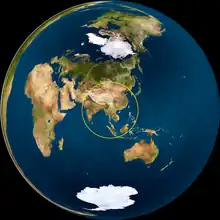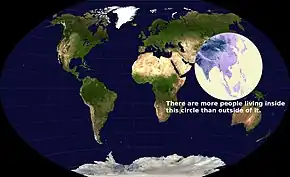玉溪圈
玉溪圈或Valeriepieris圈[1][2][3]是在地球表面绘制的一个图形,其内部分布着大部分人口。这一概念最初来自得克萨斯州ESL教师Ken Myers于2013年发布在Reddit的地图,他的用户名是Valeriepieris。[4]Myers最初绘制的圆仅占地球表面积的6.7%,半径约为4000 km,以南海为中心。[1]地图很快流传开来,成为知名的迷因,被众多互联网媒体报道。[5][6][7] Myers的原地图使用的是温克尔投影,而他画的圆没有依投影法调整,并不对应球面上的圆。[8][9]

2015年柯成兴绘制的圆,地图使用正投影

Ken Myers于2013年绘制的原始地图,圆内部反色
2015年,新加坡教授柯成兴在实习生Ken Teoh的帮助下,证实了Myers的说法,并提出了一个新的小得多的圆,以缅甸孟卡镇区为中心,半径约3300 km。[1]柯成兴声称这个圆是可能出现的最小的圆,是由更严格的计算和更新的数据得到的。
2022年,地图制作者Alasdair Rae追踪了全球1500个城市周围的4000 km半径的圈,数据基于2020年的Worldpop (页面存档备份,存于)数据,来自全球78亿人口。在1500个圈中,有148个包含40亿及以上的人口,其中中国云南省玉溪市为中心的4000 km范围内有43.2亿人口。Rae称其为“玉溪圈”(Yuxi circle)。[10] 2022年,霍特国际商学院教授Riaz Shah再次检测了Myers最初的圆。Shah利用联合国《世界人口展望》最近公布的数据估算出,截至2022年,在80亿总人口中,有42亿人生活在这个圈内。[11]
参考文献
| 维基共享资源上的相关多媒体资源:玉溪圈 |
- The world’s tightest cluster of people 的存檔,存档日期2023-06-04., Danny Quah, London School of Economics and Political Science
- More Than Half the World's Population Lives Inside This Circle 的存檔,存档日期2023-06-01., Condé Nast Traveler
- A Small Circle in Asia Contains More Than Half the World's Population 的存檔,存档日期2023-08-07., HowStuffWorks - Science
- After seeing a recent post about the population of Indonesia, this occurred to me 的存檔,存档日期2023-06-13., Reddit
- The Majority of the World’s Population Lives in This Circle 的存檔,存档日期2023-05-29., Visual Capitalist
- 40 Maps That Explain the World 的存檔,存档日期2023-09-12., The Washington Post
- Everybody Lives in Asia 的存檔,存档日期2023-08-05., Slate
- More than half of the world's population lives inside this circle 的存檔,存档日期2019-01-25., io9
- If More Than Half the Population of the World Lives in This Circle, Asia is the Future of Startups 的存檔,存档日期2022-12-12., Tech in Asia
- . [2024-01-08]. (原始内容存档于2024-01-08).
- Shah, Riaz. . Medium. 2022-11-10 [2022-11-19]. (原始内容存档于2023-05-13) (英语).
This article is issued from Wikipedia. The text is licensed under Creative Commons - Attribution - Sharealike. Additional terms may apply for the media files.